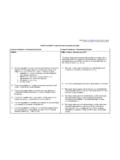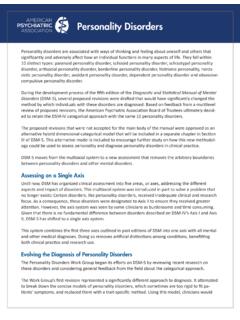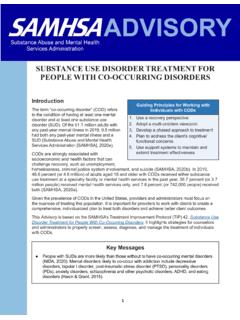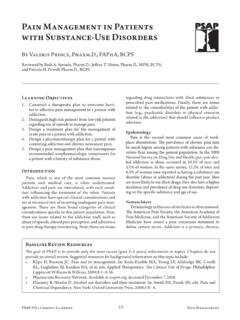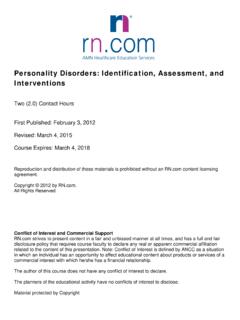Transcription of Substance Use + Mental Health in Teens and Young Adults
1 Substance Use + Mental Health in Teens and Young AdultsYour guide to recognizing and addressing co-occurring disordersSubstance Use + Mental Health in Teens and Young | Is in This Guide?Executive Summary ..4 Section One: An Introduction to Co-occurring disorders ..6 Prevalence of co-occurring disorders ..6 Risks of co-occurring disorders ..6 Section Two: An Overview of Substance Use ..7 What s the attraction? ..7 Substance use basics ..7 What Is a Substance Use Disorder? ..8 Section Three: Differential diagnosis: Which symptoms come from which disorder? ..10 What's causing these symptoms? ..10 Getting an evaluation ..11 Examples of evaluation results ..11 Section Four: Depression ..13 Major Depressive Disorder ..13 Persistent Depressive Disorder.
2 13 Treatment for depression ..14 Depression & interaction with Substance use ..14 Section Five: Anxiety disorders ..15 Types of anxiety in Teens and Young Adults : ..15 Signs of Anxiety disorders ..15 Treatment for Anxiety disorders ..16 Anxiety disorders & interaction with Substance use ..16 Section Six: Attention-Deficit Hyperactivity Disorder (ADHD) ..17 Characteristic signs and symptoms of ADHD ..17 Treatment for ADHD ..17 ADHD & interaction with Substance use ..18 Substance Use + Mental Health in Teens and Young AdultsYour guide to recognizing and addressing co-occurring disordersSubstance Use + Mental Health in Teens and Young | What's in this guideSection Seven: Bipolar Disorder ..20 Symptoms of Bipolar Disorder ..20 Signs of mania in Bipolar Disorder.
3 20 Signs of depression in Bipolar Disorder: ..20 Treatment for Bipolar Disorder & interaction with Substance use ..21 Section Eight: Schizophrenia ..23 Signs of Schizophrenia ..23 Treatment for Schizophrenia ..24 Schizophrenia & interaction with Substance use ..24 Section Nine: Signs of Borderline Personality Disorder ..25 Borderline Personality Disorder ..25 Treatment for Borderline Personality Disorder ..26 Borderline Personality Disorder & interaction with Substance use ..26 Section Ten: Encouraging Your Teen or Young Adult to Seek Treatment ..27A note about required consent for treatment ..29 Alternatives to treatment ..29 Addressing crisis situations ..29 Non-emergency Eleven: Quality Treatment and How to Get It ..31 What should you look for in a quality treatment program?
4 33 Section Twelve: The Family Role in Supporting Your Child ..35 Encourage treatment participation ..35 Provide emotional support and encouragement ..36 Participate in family education ..36 Attend individual and family counseling ..36 Assist with medication management ..36 Encourage abstinence ..37 Help establish structure and meaning ..37 Promote healthy social supports ..37 Join family support groups ..38 Foster coping skills ..38 Engage in self-care ..39 Know the signs of relapse ..39 Section Thirteen: Resources for Co-occurring Mental Health and Substance Use disorders ..40 Substance Use + Mental Health in Teens and Young | SummaryThis guide, a collaboration of the Child Mind Institute and Partnership to End Addiction, provides information on common Mental Health disorders in Young people (and the medications that are often used to treat these), tips on identifying Substance misuse and steps to making informed decisions about evaluation and treatment for co-occurring s say you ve noticed that a teen has become increasingly moody and anxious.
5 Is this the sign of a Mental Health disorder? Or is it Substance use? Or could it be both?What might be behind a Young person s change in behavior is often hard to pin down, particularly when Substance use and Mental Health are both factors. But understanding how these challenges can manifest in a child s life, and sometimes entwine to create new problems or complicate treatment, is essential to keeping kids healthy. Key Takeaways from This Guide: y30% 45% of adolescents and Young Adults with Mental Health disorders have a co-occurring Substance use disorder, and 65% or more of youth with Substance use disorders also have a Mental Health disorder. yUntreated, co-occurring disorders increase risk for self-harm. yThorough evaluation, diagnosis and treatment planning of co-occurring disorders requires a professional with expertise in both Mental Health and addiction.
6 YSymptoms of Substance misuse and Mental Health disorders mimic each other. yMental Health disorders often lead to self-medication with substances. Certain substances are often associated with specific disorders . yParents are instrumental in encouraging treatment for their child or Young adult and supporting a treatment program. yIntegrated care combining primary care, Mental Health and Substance use services for co-occurring disorders offers the best long-term and Young Adults with a Mental Health disorder have a co-occurring Substance use disorderYouth with a Substance use disorder also have a Mental Health disorder30% - 45%65% or moreSubstance Use + Mental Health in Teens and Young | children are struggling with both a Substance use disorder and a Mental Health disorder, they are said to have co-occurring disorders .
7 You may also hear these referred to as "comorbid disorders " or a dual diagnosis. The disorders may have developed at the same time, or one might have led to the other. Either way, co-occurring disorders can bring a host of questions. How worried should parents be if a child has anxiety and is smoking pot? If a Young adult has depression and is drinking, where should treatment begin? Is a child diagnosed with ADHD more vulnerable to developing a problem with substances?If you are a parent or caregiver, teacher, or community member concerned about a child s Mental Health or Substance use, you are in the right , you will find sections covering the issues below:A note about parents :We know supportive roles in a child s life come in many forms.
8 Though we might refer to parents often in this guide, whether you are a parent, stepparent, grandparent, foster parent, aunt, uncle, supportive sibling or another caregiver, this guide is for you. Executive SummarySections Two and Three: What is a Substance use disorder, and how do Mental Health and addiction professionalstell the difference between Substance use and Mental Health symptoms? Sections Four through Nine: What do common Mental Health disorders look like in Young people, and how do they interact with substances like alcohol, nicotine and marijuana? Section Ten: How can parents help Young people want to get help for a Substance use or Mental Health disorder? Section Eleven: How can Young people get quality diagnosis and treatment?
9 Section Twelve: What is the family s role in supporting Young people during treatment?Sections Thirteen:What are some additional resources for parents who want to learn more or get help? We know the combination of Substance use and Mental Health disorders can create a challenging situation. As a parent and caregiver, it's common to feel overwhelmed and frustrated trying to find answers. The intent of this guide is to provide useful information, insights and resources that can help make this journey easier and help you get quality care for your child. Substance Use + Mental Health in Teens and Young | OneAn Introduction to Co-occurring DisordersKey Takeaways: y30% 45% of adolescents and Young Adults with Mental Health disorders have a co-occurring Substance use disorder.
10 YIf untreated, Mental Health disorders can pose serious risks for problematic Substance use. ySimilarly, Substance use poses a serious risk for developing a Mental Health disorder in the future. yHelping to identify risk factors and protective strategies early on can help prevent these of co-occurring disordersOver million adolescents (aged 12-17) and million Young Adults (aged 18-25) used illegal drugs or misused prescription medications in the in 2014. About million adolescents and million Young Adults more than half of the Young adult population consumed alcohol in the past and Young Adults with a Mental Health disorder have a co-occurring Substance use disorder30% - 45% Mental Health disorders are a subject of increasing concern for Young Adults .


